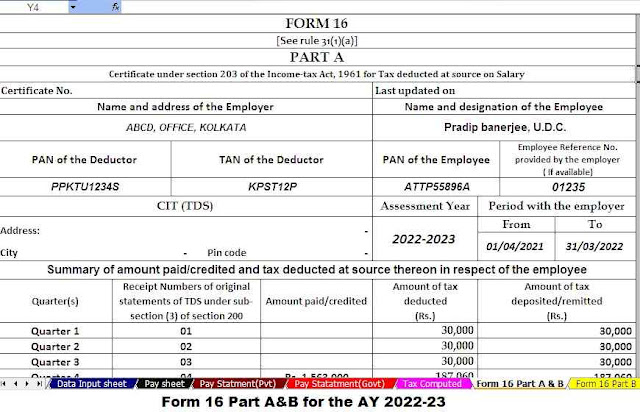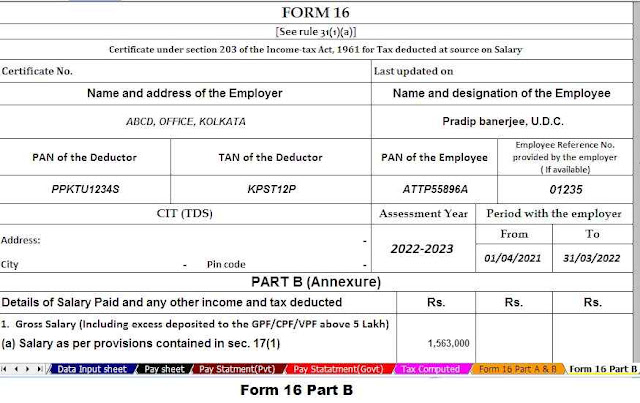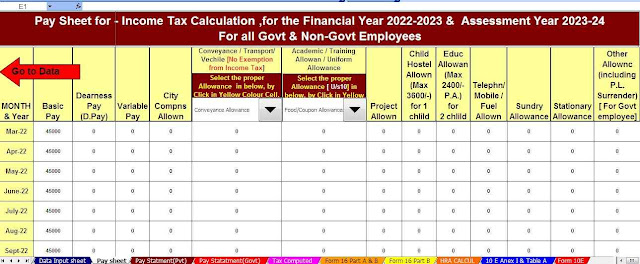Income tax deductions under section 80 CCD (1B)| Income tax is required for all citizens of India who
are required to pay income tax in accordance with the rules and regulations of the Income Tax Act
1961. But this does not mean that you have to pay tax on all income received by you in this financial
area. year. There are several provisions in the Income Tax Act that allow you to claim deductions from
certain investments and expenses.
Plan your taxes to save your income
You may carefully be planning your taxes, you can save a maximum amount on your tax liability and create an extra source of income for yourself. With the dual benefit of tax savings and income generation, these deductions provide significant benefits. From time to time, the government introduces new deductions or amendments, which you should keep a close eye on. One such deduction available to you is CCD Sec 80 (1B), which applies to contributions made to the NPS.
Download and Prepare at a time 100 Employees Form 16 Part B for the Financial Year 2021-22
About NPS
NPS or the National Pension System is a pension scheme available to both government employees and individuals. NPS is one of the most popular options available for people looking to set up a retirement fund along with a regular monthly income. Money deposited with NPS is invested in a variety of securities and investment opportunities, including the stock market. It is widely regarded as one of the cheapest equity investment options. Since returns are directly related to market performance, there is no guarantee of any particular value, but over time, NPS returns become one of the highest in the market.
Should you know that Two Types of NPS Accounts
Two types of NPS accounts: NPS Level 1 and NPS Level 2.
Level 1 account: has a fixed lockout period until the subscriber reaches the age of 60. Withdrawals are entitled to be subject to certain conditions. Contributions made in Tier 1 are tax-free and deductible in accordance with Section 80CCD(1) and Section 80CCD(1B). You can invest up to Rs. 2 lakh in NPS Level 1 account and claim a deduction from the total amount i.e. rupees. 1.50 lakh under section 80CCD(1) and Rs. 50,000 under section 80CCD (1B).
Level 2 Account: This is a mandatory voluntary savings account that allows subscribers to withdraw money as they wish. But a contribution made to a Tier 2 account is not eligible for a tax deduction. In order to open a Tier 2 account, you must first open a Tier 1 account. Contributing to NPS is now subject to a tax exemption (EEE) regime where the amount contributed to NPS, income received and redemption value are all tax-deductible. rid. According to the latest recommendations, you can withdraw up to 60% of the amount at maturity and must reinvest the remaining 40% to buy an annuity that will give you a regular monthly income.
Download and Prepare at a time 100 Employees Form 16 Part A&B for the Financial Year 2021-22
What is section 80CCD (1B)
Section 80CCD of the Income Tax Act deals with deductions offered to individuals who contribute to the NPS. Under section 80CCD, prior to 2015, an individual was eligible to claim a tax deduction of up to Rs. 1 lakh against contributions made to NPS. As per the 2015 budget, the government increased the maximum amount payable to the NPS to Rs. 1.50 lakh per year. In addition, a new subsection 1B was introduced which offered an additional deduction of up to Rs. 50,000/- for contributions made by individual contributors to the NPS.
Extra deduction in the amount of Rupees Fifty Thousand pursuant to section 80CCD (1B) available for valuation in excess of Rupees One Lakh and Fifty Thousand is available as a deduction under section 80CCD(1). Thus, raising the upper limit of the exemption to Rs. 2.00 lakh with Section 80CCD(1) + Section 80CCD(1B).
DID YOU KNOW?
Section 80C+ Section 80CCC+ Section 80CCD(1) For example, consider yourself an individual who invests Rs. 1 50 000 / - in accordance with Section 80C (PPF, Tax Saver FD, ELSS, etc.). Now you have decided to deposit Rs. 70,000/- per year for NPS. Now you can claim a deduction of 50,000 thousand. Total Rs. 2.00 lakh, i.e. 1.50 lakh under section 80C and Rs. 50,000 / - in accordance with section 80CCD (1B).
What to look for when claiming deductions under section 80CCD(1B)
Here are some important points regarding Section 80CCD(1B) that you should be aware of.
Additional deduction in the amount of Rs. 50,000/- is only available for contributions made to NPS Tier 1 accounts.
Level 2 accounts are not eligible to claim the deduction under section 80CCD(1B).
Section 80CCD(1B) deductions are available to both employees and the self-employed.
You need to provide documentary proof of the transaction associated with the NPS contribution.
Partial withdrawals are permitted by the NPS but subject to certain conditions.
Download and Prepare at a time 50 Employees Form 16 Part B for the Financial Year 2021-22
The normal exemption limit under section 80CCD(1B) is Rupees Fifty Thousand and is not subject to exceptions under section 80 C. As such, you may qualify for a maximum deduction of Rs. 2,00,000/-
If the defendant dies and the nominee decides to close the NPS account, the amount received by the nominee is exempt from tax.
With a partial withdrawal of funds from the account, only 25% of the contribution made is exempt from taxation.
If the assessee is an employee and decides to close the NPS account or decide not to participate in the NPS, only 40% of the total amount is tax-deductible.
The appraiser can withdraw 60% of the total amount upon reaching the age of 60 as non-taxable income. The remaining 40% is also tax-free if used to purchase an annuity plan. Section 80CCD(1B) offers you an excellent opportunity to save a significant amount on your tax liability.
This way, you can not only reduce your current tax liability but also work towards building a substantial body for retirement. Please be aware of the points above before taking any action with respect to your NPS account in connection with section 80CCD(1B).
Download and Prepare at a time 50 Employees Form 16 Part A&B for the Financial Year 2021-22
Benefits for existing NPS subscribers
Existing NPS subscribers may also benefit from the deduction under section 80CCD (1B) in addition to the deduction of Rs 1.5 million under section 80C. They may claim an additional deduction of Rs 50,000 from their contribution in accordance with Section 80CCD (IB). They can split their NPS contribution and claim partly at 80C and the rest at 80CCD (1B), making the most of the 2 lakh tax deduction. Check out NPS tax credits:
Note. From April 1, 2019, the central government contribution to the NPS for its employees is increased to 14%. maximize your tax benefits.
Feature of this Excel Utility:-
1) This Excel utility prepares and calculates your income tax as per the New Section 115 BAC (New and Old Tax Regime)
2) This Excel Utility has an option where you can choose your option as New or Old Tax Regime
3) This Excel Utility has a unique Salary Structure for Government and Non-Government employees Salary Structure.
4) Automated Income Tax Arrears Relief Calculator U/s 89(1) with Form 10E from the F.Y.2000-01 to F.Y.2022-23 (Update Version)
5) Automated Income Tax Revised Form 16 Part A&B for the F.Y.2022-23
6) Automated Income Tax Revised Form 16 Part B for the F.Y.2022-23









0 Comments